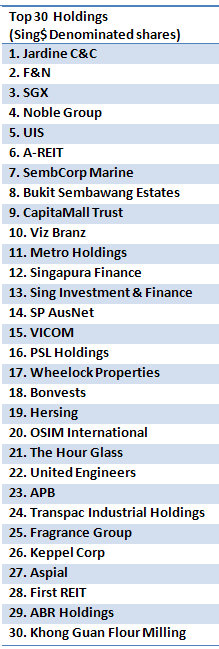The following article by ghchua, a full-time investor, was recently published on his blog, http://ghchua.blogspot.com, and is reproduced with permission.

2012 is predicted to be another tough year by analysts. Euro zone problems, weak US economy, China issues etc.
But as readers might have noted, at the start of 2011, analysts were predicting that the markets would continue to run ahead and the outlook was good then.
Therefore, do take predictions with a pinch of salt. Yes, there are issues yet to be solved but that is why you can buy stocks cheaply. Do not be afraid to buy when things don't look good. The key is to spread your investments and don't commit all your money in one go. Also, do remember to diversify your assets.
What will be my investment strategy for 2012? Well, they are summarized below:

1. Continue to seek value. Value investing had served me well since the 2nd half of 2010 when I decided to position my portfolio more defensively when the markets had run up substantially after the Global Financial crisis. I will continue to avoid high growth stocks at this moment.
2. Reduce costs. Again, I will try to minimize sell trades to save on costs. I will not hesitate to buy multiple stocks to diversify my portfolio but I can control the sell trades by not engaging in switching or sector rotation activities.
3. Continue to engage in rights issues. Rights issues are good opportunities for investors to increase their stake in companies without incurring brokerage costs.
However, in a weak market, investors must be selective and only commit capital in those companies that are well-managed.
4. Participate in scrip dividend scheme. A scrip dividend scheme is a good way for investors to re-invest their dividends back into the company at a discounted price, without incurring brokerage costs. In 2011, I participated in quite a few of these schemes and they had bore fruit, especially high dividend paying stocks like SP AusNet and Second Chance Properties.
The compounded return from re-investing the dividends will yield higher absolute dividends the next time a dividend is declared, even if the amount declared is the same.
5. Continue to overweight better stock ideas. I think readers would have noticed from my stock purchases in 2011 that most of them are the same existing stocks. This is because since I became a full-time investor, I decided to focus my research on my existing stocks and also add more capital to them.
This is a slight change from my previous strategy of diversification across all stocks, without concern about their individual weights in my portfolio.
6. Match cash flow with expenses. Since I am now living on my investment returns, I do not have consistent income every month. Though I still receive income in the form of dividends, they are inconsistent every month. Therefore, I need to preserve some cash during low dividend paying months to pay for my expenses.
This will result in a cash drag in my portfolio for some months, but that is a tradeoff for matching cash flow with expenses.
7. Work on my CPF stock investment and CPF unit trust investment. Since I left my day job, I have not received any CPF contribution every month. Therefore, I have not been buying any stocks using CPF funds since then, as my CPF stock investment limit had not increased.
Also, since I transferred those dividends received from my CPF stock investment back to my CPF-Ordinary Account, the stock limit has actually gone negative, due to a lack of fresh CPF contribution.
The CPF stock investment limit has been a pain in the neck for me, as I cannot continue to invest in new stocks even if I have funds from dividend distribution. I might need to make some minor changes to my CPF stock investment portfolio. I have also neglected my CPF unit trust investments in 2011, and I need to review those unit trusts and determine action plans (if any) for them in 2012.
All in, there are a lot of things to be done. Besides managing my own portfolio, I will still actively attend AGMs/EGMs.
To all readers, have a great year ahead!
Previous article by ghchua: JUST ASK: 'Is it silly to buy and hold (instead of trading)?'


My portfolio is very widely diversified. When I started on my investing journey, I was working full-time and also do not have any experience in finance or investment. I was Engineering trained.
Therefore, I dunno how to pick stocks during that time. So, I just collect and participate in the market.
As I move along, I become more experienced and I started to overweight some better stock ideas. I also did not add a lot of new stocks anymore. Therefore, the portfolio still have a lot of stocks, but now there are meaningful weights in those stocks that I think have potential to outperform.
My investment strategy envolves as I get older. I am still learning as I move along.
Anyway, it's more profitable than collecting CDs or even books. You must be having a net worth in excess of S$1 million, by my guestimate. Anyway, good luck -- this current stock rally should hv boost your portfolio by >$100K already, I think.
I don't really compute my CAGR as I am more interested in my stock selection and portfolio management process than computing returns. As I have a big portfolio, it is very time consuming to compute CAGR, especially when I have cash inflow/ouflow every month from dividends, general offers. I even do stuff like warrant conversion etc. I don't wish to go into tracking every single dollar and cents.
But my dividend yield for the past few years had been around 4%pa.